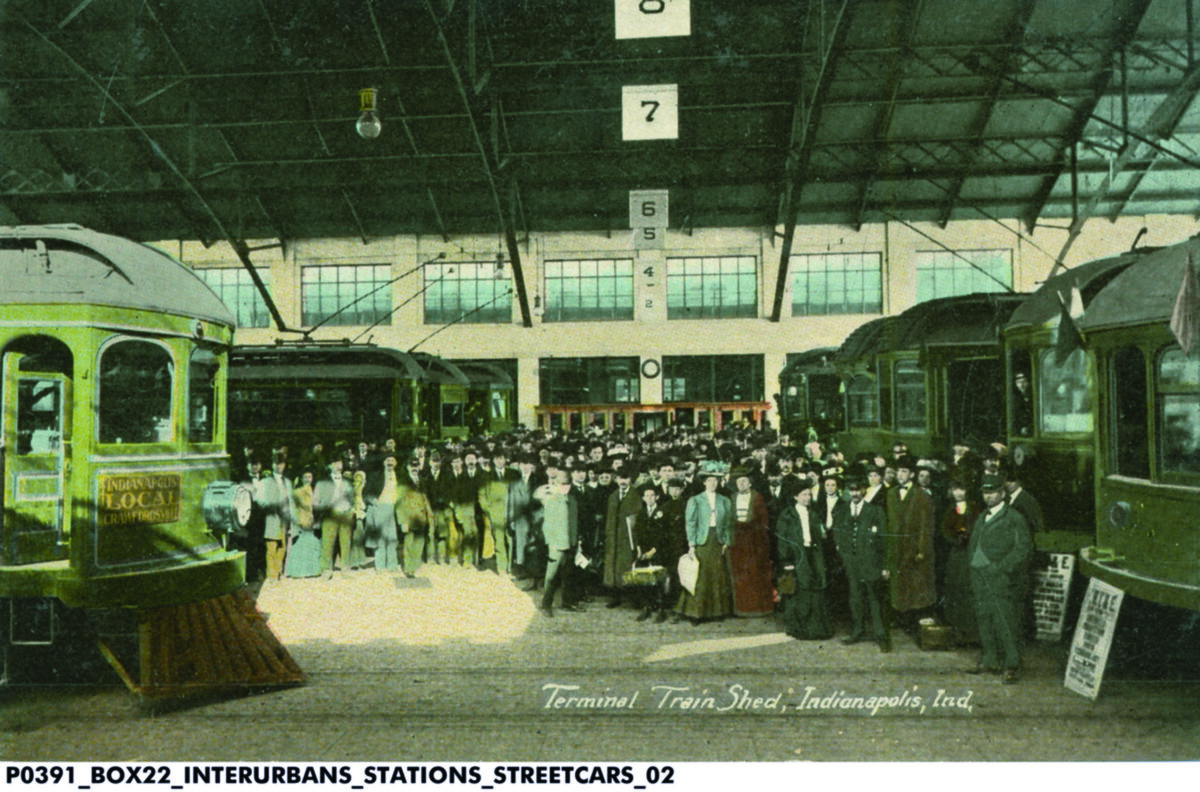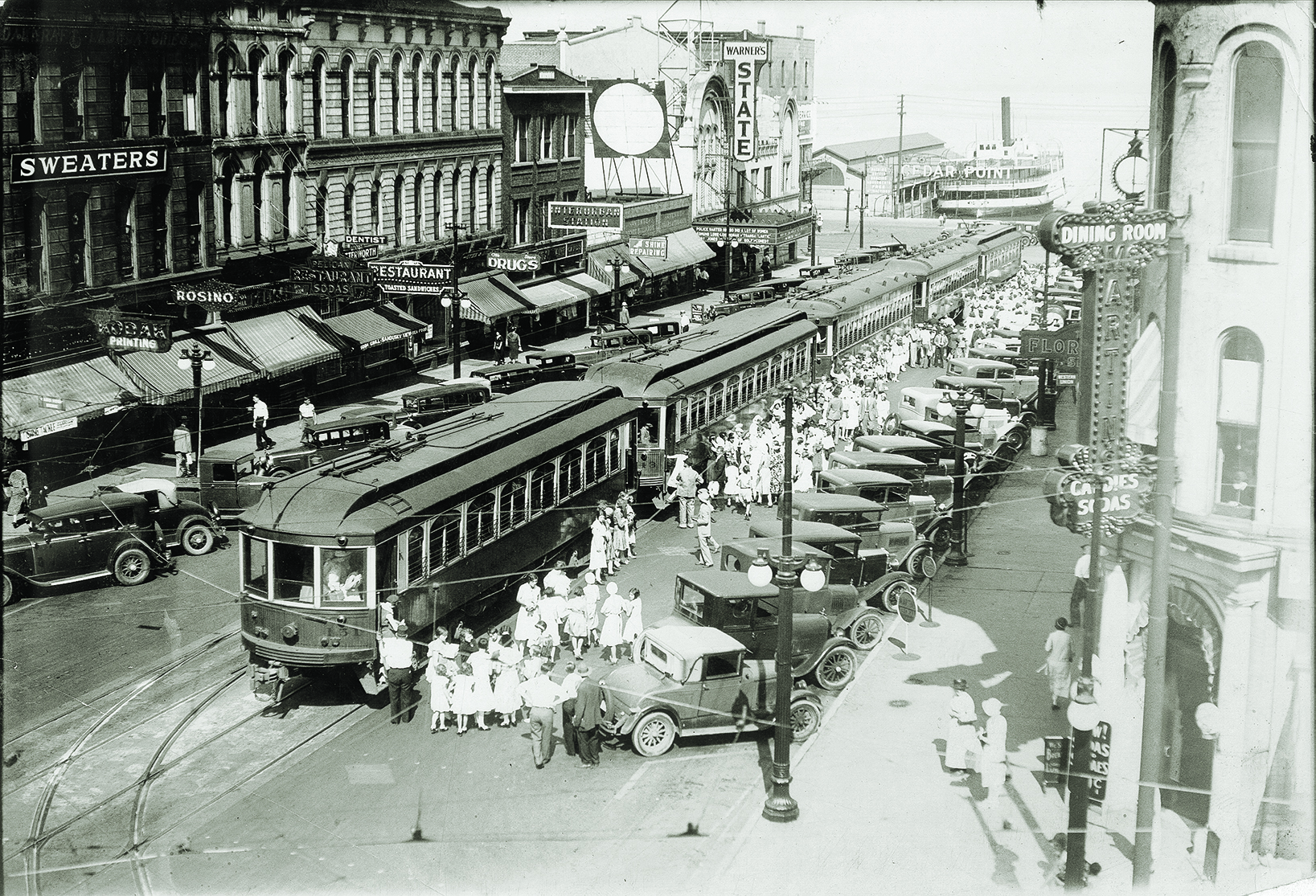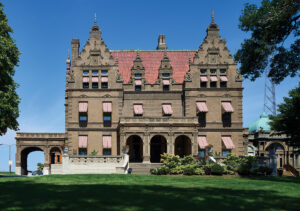Before commuter rail lines, interurban lines electrically connected cities, small towns, and even amusement parks
ON WEEKDAYS IN THE 1910s, the waiting room at the Indianapolis Traction Terminal welcomed hundreds of travelers—men wearing straw boaters or derbies, women in wide-brimmed hats and ankle-length skirts—debarking from or waiting to board trains to and from South Bend and Terre Haute, Indiana, Columbus, Ohio, and elsewhere. At the adjoining train shed, 500 trains, operated by 12 interurban railway lines, came and went daily, carrying some seven million passengers a year. Indianapolis Traction was the nation’s largest interurban terminal. By 1941, the trains were gone. The building became a bus terminal, was shuttered in 1968, and in 1972 was torn down—a capsule history of American interurban electric rail. The site of the interurban terminal, demolished in 1972, now is the location of the Hilton Indianapolis.
“Interurban” means “between cities,” but as a means of transit the definition is looser. Interurbans were hybrids of the city streetcar line and the suburban commuter railroad as those transportation modes existed before the automobile. Streetcars mostly stayed within a city’s limits, but interurbans lived up literally to their Latinate name, connecting municipalities and bringing mass transit to small-town and rural America. Like a streetcar, an interurban usually got power supplied by overhead electric wires fed by a coal- or oil-fired power plant. The wires propelled one- or two-car trains.
Electric traction—transport systems, tracked and not, that run on electricity—made possible both the interurban and the streetcar, which replaced railcars drawn by horses and sometimes by cable. As early as the 1830s, inventors were using batteries to power railcars, but those systems were slow and ran only short distances. In the early 1880s, Baltimorean Leo Daft introduced a more reliable and effective system powered by overhead wire. In 1888 former naval officer Frank Sprague, of Richmond, Virginia, pioneered improvements, such as a non-sparking electric motor mounted on the car’s underside and powered by a spring-laden pole, or trolley, connecting to an overhead wire by means of a rotating wheel. Within a year of Richmond installing trolleys, more than 100 cities were developing electric streetcar systems.
A seven-mile interurban line connecting Newark and Granville, Ohio, built in 1889, and a 13-mile line between Portland and Oregon City, Oregon, built in 1893, each has been called the first true interurban. But the trend’s genuine beginning, according to The Electric Interurban Railways in America by George Hilton and John Due, dates to 1895, when Henry Everett and Edward Moore built the Akron, Bedford and Cleveland Railroad. The two, veterans of other public utility projects, used profits from their successful Akron venture to form a syndicate that built interurbans in Ohio, Michigan, and Canada. By 1900, the Everett-Moore Syndicate controlled more than 500 miles of track, and an interurban boom, interrupted slightly by economic panics in 1903 and 1907, was on. By 1917, interurban operators had laid 18,000 miles of track around the United States.
Though rare in the impoverished and mostly rural Deep South, lines proliferated elsewhere, especially in the heartland. “In the Midwest, you had many large population centers like Cleveland, Toledo, and Mansfield, and they were spread out over a wide distance and needed to be connected,” explained Jeffrey Kraemer, an electric traction researcher in North Carolina. “You had lots of flat land, which was easy to grade. And there were lots of industries.” Industrial customers used interurbans to haul freight, whether raw materials or finished products.
Operators financed construction by selling stocks or bonds to utilities, bankers, industrialists, politicians, developers, and individual investors. “When the Texas Electric was being built, its salesmen approached banks up and down the line and asked them to buy stock,” said Robert Haynes, curator with the Interurban Museum in Plano, Texas. “Most did, since the interurban was the ‘new thing.’ Some even required their employees to buy stock, too.”
The biggest system was the Pacific Electric Railway. In the 1910s and ’20s, that line had more than 1,000 miles of track. “It connected Los Angeles with Long Beach, Venice, San Bernardino, Santa Ana, cities all over southern California,” said Harvey Laner, archivist for the Orange Empire Railway Museum in Perris, California. In 1914, according to The Interurban Era by William Middleton, 1,626 trains entered or left Los Angeles every day over Pacific Electric lines. The Pacific Electric was the creation of rail tycoon, developer and art collector Henry R. Huntington, nephew of Colin Huntington, a founder of the Southern Pacific. The younger man, who had apprenticed under his uncle for years before going out on his own, saw real estate and rails as intertwined—wherever he built his lines, he built houses, and vice versa. His Huntington Beach Company founded the Orange County town of that name in 1909. Huntington helped introduce surfing to California by bringing Hawaiian board ace George Freeth to Redondo Beach in 1907. He also founded the art musem bearing his name. In 1898, he purchased and built up the Los Angeles Railway, a streetcar line whose “Yellow Cars” would share inner-city tracks with the Pacific Electric’s “Red Cars.”
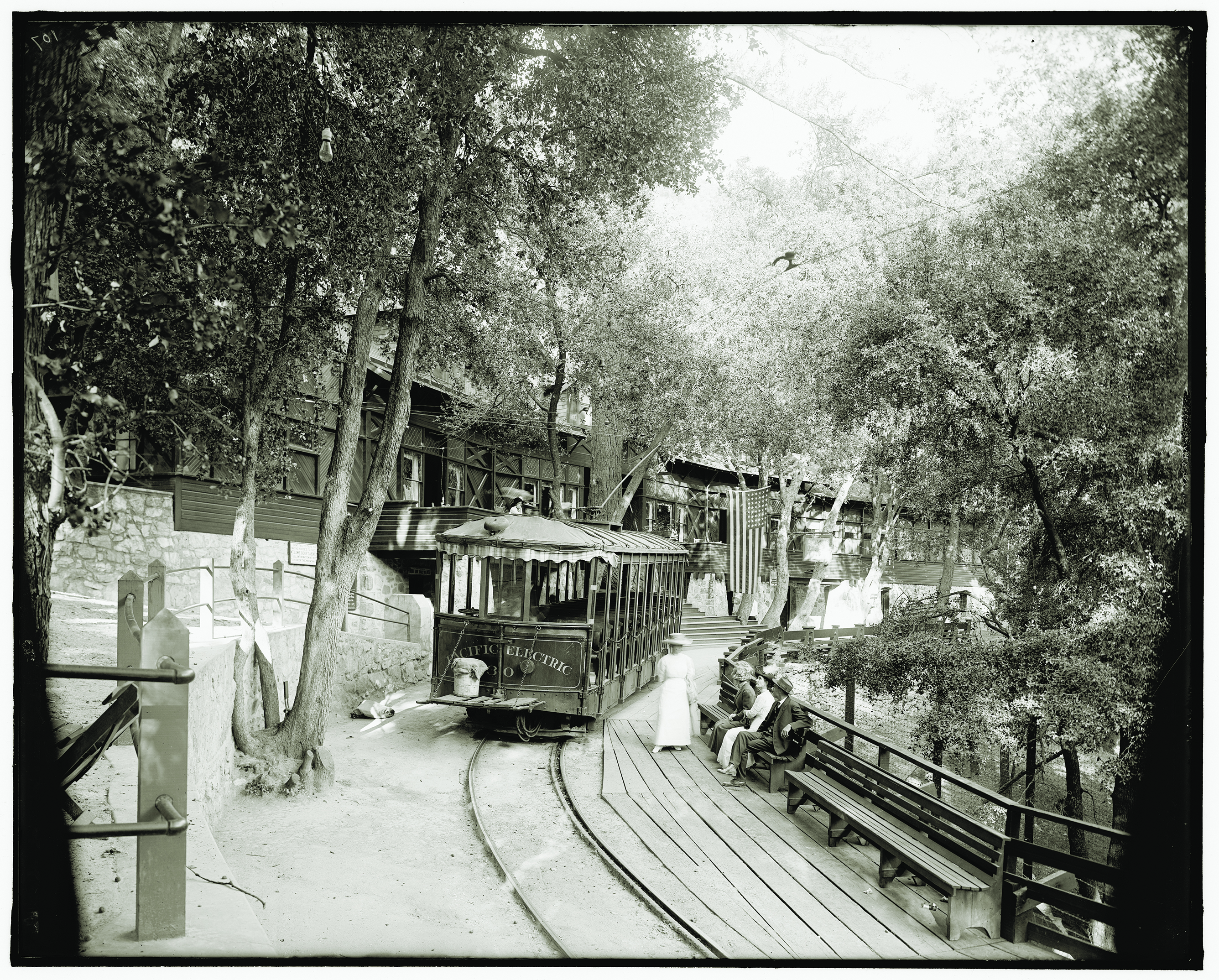
In 1901, Huntington and banker Isaias Hellman founded the Pacific Electric. The first line, to Long Beach, opened in 1902, followed by lines to Newport, Santa Ana, Pasadena, and elsewhere. Most interurban lines had only one track, but many Pacific Electric’s lines had two sets, and two segments were four-tracked—two for locals, two for express trains. The Pacific Electric largely spurred the growth of suburban Los Angeles.
Nationwide, if interurbans had a rival, it was the railroad. Electric interurbans were faster and cleaner than wood- and coal-powered steam trains belching smoke and cinders. At a rural hamlet the train might stop a few times a day. Interurbans passed by at least hourly. Light, self-propelled interurban cars offered flexibility. “Steam trains took a long time to start up and to slow down, but an interurban could stop on a dime,” said Kraemer.
In locales where interurban lines paralleled steam railroads, interurbans poached customers with slogans like “No Dust, No Dirt, No Smoke, No Cinders.” Trying to keep the new breed from growing, railroads often barred interurban freight from their tracks or forbade grade-level crossings, forcing interurban operators to build costly bridges.
Sometimes conflict broke into the open, as in 1907’s “Battle of the Bee Farm” in northern California. The Northern Electric Railway and rail tycoon George Gould’s Western Pacific Railroad each were building lines to Sacramento from Chico in northern California. The routes crossed near an apiary in Marysville, California. According to Middleton, railroad men reached Marysville first, quickly caught an interurban’s track gang that ripped up the just-laid Western Pacific track and put down tracks serving the interurban line. The apiary is still around.
Once Pacific Electric began operating, Southern Pacific president E.H. Harriman applied his influence with regulators to harry Huntington. In 1903, following a bidding war, Huntington made Harriman a partner in exchange for several benefits, including rights to the key Sixth Street rail franchise in Los Angeles. Hellman sold his shares in 1904. Harriman died in 1909. After more disputes, the railroad bought out Huntington in exchange for total control of local Yellow Cars. In 1911, now owning several Los Angeles-area electric rail lines, the Southern Pacific merged them with Pacific Electric.
The expanded Pacific Electric—motto: “From the Mountains to the Sea”—had four sectors. The Northern District served the San Gabriel Valley. The Western District ran west of the city center in such areas as Hollywood, Beverly Hills, and Santa Monica. The Southern District reached Long Beach, Newport Beach, San Pedro, and other shore towns. The Eastern District, created a few years later, included San Bernardino, Redlands and Pomona. In 1917, an elevated terminal opened downtown at Sixth and Main streets. In 1925, an underground subway terminal opened on South Hill Street, connected by subway to surface tracks.
As most interurbans did, the Pacific Electric (P&E) generally ran on tracks installed at street level, often sharing rails with local streetcars. In rural areas, interurban rights-of-way typically paralleled roads, offering operators a chance to pick up speed on straightaways. Interurban cars averaged 55 to 60 feet in length; streetcars were about 45 feet. Interurbans usually maintained smoking and non-smoking sections. Texas Electric had segregated women’s sections to separate female passengers from commuting oilfield roughnecks, according to Haynes of the Interurban Museum.
Interurban passengers were diverse: commuters, door-to-door salesmen, students, couples on dates, farmers’ wives headed for town to shop, farmers on buying trips. For special events like state fairs, big sports games, college homecomings, and theatrical presentations, interurbans ran excursion cars with wood paneling, wicker or plush seats, and perhaps a buffet with a waiter serving coffee. Lehigh Valley Transit Company produced “Honeymooning at the Delaware Water Gap,” promoting that popular Pennsylvania resort area. Booklets like “New England by Trolley,” published in 1909, offered travel advice. In 1904, aviation pioneers Orville and Wilbur Wright brought their prototype biplane from Kitty Hawk, North Carolina, to a location an hour outside Dayton, Ohio. The Wrights commuted eight miles between their bicycle shop and makeshift airfield aboard the Dayton, Springfield, and Urbana interurban line.
Pacific Electric excursion service included the narrow-gauge Alpine Division, which ran up and down snow-capped Mount Lowe in the San Gabriel Mountains. The day-long Balloon Route, pitched as “101 miles for 100 cents,” which the P&E inherited from the rival Los Angeles-Pacific when it absorbed that line, took tourists around greater Los Angeles. Special cars ran to Santa Anita racetrack and to the Tournament of Roses in Pasadena.
To boost Pacific Electric ridership, in 1909 Huntington built the Redondo Beach Plunge, billing it as the world’s largest heated saltwater pool. Fed by the Pacific, the Plunge was popular for years. Attendance declined in the 1930s, and the watery attraction closed in 1941.
On interurbans throughout the U.S., excursion cars were available for rent to groups like Elks Club chapters and other fraternal bodies, school field trips, women’s clubs, and business organizations. “The Ku Klux Klan rented cars on the Texas Electric,” said Haynes. “They didn’t put their robes on until they left the car.”
Freight was a profitable interurban sideline, carried on cars equipped to haul produce, grain, gravel, timber, hay, and milk, the last traveling in giant metal cans. Freight traffic served local needs—the Piedmont and Northern, traversing textile-mill country in the Carolinas, bragged of serving “A Mill a Mile.” The Los Angeles-Pacific called itself “the Lemon Growers’ Express.”
Unlike steam railroads, interurbans delivered at night and, because their tracks ran on city streets, could run to warehouses. Municipalities complained of damage to streetcar tracks and pavement, and noise irked neighbors, but in 1925, electric railways reported to the Interstate Commerce Commission $39 million in freight revenue and $153 million in passenger fares—today, $557.5 million and $2.81 billion, respectively.
Social media postings are alive with video and stills of interurban days. YouTube post “Rail Recollections Part 4” features Bernard DuPlessis Sr. (1904-92), who grew up in Newark, New Jersey. “They just had one line from Newark to Trenton, which was really a regular trolley car, just painted differently,” he explains. But when as a youth DuPlessis visited Syracuse, New York, an interurban hub, it was a different story. “They had a line to Auburn and another one to Rochester,” he says. “That’s a pretty good distance, and in the other direction a line to Utica. [Interurban cars] were tremendous big cars. I thought they were beautiful.”
A 2007 episode from “Tales of Allen” is another YouTube fixture, featuring the late Bud Ereckson, who rode interurbans, known by the shorthand “urbans,” from that small Texas town to Dallas, first for entertainment and then for work. “There were a lot of people commuting on the urban,” he tells viewers. “If you were going to catch an urban at 7 o’clock, there’d be two urbans, back to back.” As a teen, he found the “urban” a lifeline. “Didn’t any of us have vehicles,” he says. “We’d go down to catch an urban and go to McKinney and go to the Majestic Theater to go to the movies for entertainment.”
Young drivers put interurbans to a different use. In “Racing the Interurban,” Maine resident Clyde Walker Pierce remembers pitting his auto against the Portland-Lewiston Interurban on a straightaway. “I clocked that electric car at 78 mph,” Pierce says. “It was fast! And the people on it were waving and hollering, ‘Go, go, go!’”
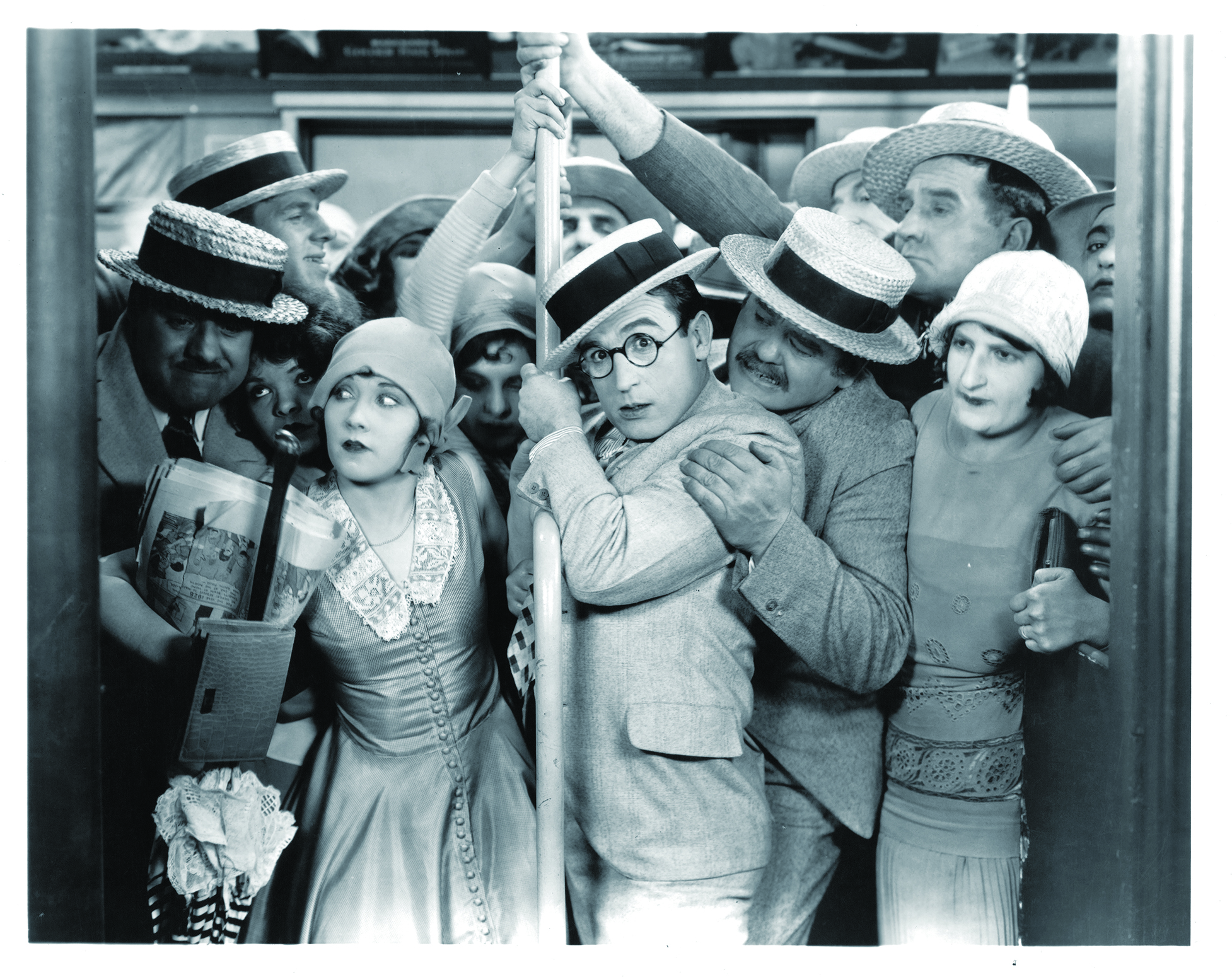
Hollywood featured interurbans—especially the Pacific Electric, which served Tinseltown. In 1924’s Girl Shy, comic actor Harold Lloyd hijacks a Red Car but loses control. The railcar hits full speed, narrowly missing pedestrians. When the trolley pole falls off, Lloyd climbs atop the roof to re-attach the trolley. When he makes the connection, the car races off, and more slapstick ensues. Red Cars also figured in jazz history—bassist Charles Mingus and reed player Buddy Collette sometimes jammed in the aisles.
As quickly as they had bloomed, interurbans faded, thanks mainly to the availability of affordable motor vehicles. Track abandonments began in the mid-1920s, multiplying during the Depression. Return on investment among interurbans dropped from 3 percent in 1920 to -0.1 percent in 1939; the number of miles in service plunged from 15,337 to 3,711 during that period. In the 1920s, licensed American drivers tripled to almost 23 million. States and counties paved dirt roads. Automobiles and trucks freed travelers and shippers from rail schedules. In 1931, Cleveland Plain Dealer reporter Roelf Loveland, to commemorate the final run by the Cleveland, Southwestern and Columbus “Green Line,” wrote this poem, quoted in H. Roger Grant’s Electric Interurbans and the American People:
Oh, the trucks and the buses and the automobiles
Have killed the merry rumble of the “Green Line” wheels.
They grabbed up her fares, on her freight they fed.
Shed a tear, Old Settler: The “Green Line’s” dead.
Some interurban operators kept their lines going but slashed spending to maintain tracks, overhead wires, and substations. Railbeds grew weedy, smooth rides got jerky, rust pocked car bodies, windows stuck open or closed. Eventually lines shut down or switched to buses. Better capitalized lines tried to sell faster service. In 1930 the Cincinnati & Lake Erie introduced high-speed, lightweight “Red Devils”—interurban cars made of steel and aluminum with leather bucket seats, luggage compartments, and bathrooms. In a race between an airplane and a Red Devil car, the interurban won. The line went under in 1939, its snazzy cars sold off. In 1931, the Philadelphia and Western (P&W) introduced all-aluminum “Bullet” cars whose aerodynamism was fine-tuned in a wind tunnel. Red Devils and Bullets could reach 80 mph, and until 1990 some repurposed Bullet cars were running on the P&W, which eventually merged into the Philly area mass transit system.
A few interurbans converted from passenger service to freight hauling, like the Cedar Rapids and Iowa City (CRANDIC) line. In the 1930s and ‘40s, that line’s high-speed passenger cars had an identifiable motion that gave rise to the unofficial slogan, “Swing and Sway the CRANDIC Way,” a nod to a swing-era bandleader’s radio show, “Swing and Sway with Sammy Kaye.” In 1953, the CRANDIC way shifted to freight and converted to diesel. The line still serves some of Iowa’s largest businesses.
During World War II, fuel and tire rationing brought surviving interurbans a reprieve as travelers returned to the rails, but with peace came closure upon closure, sometimes sudden, sometimes, as with the Pacific Electric, drawn out. The first major blow was the Depression. Between 1929 and 1933, its revenues shrank by half. Management closed several lines between 1938 and 1941, including service to Pomona, Redondo Beach, San Bernardino, and other once-major destinations. General Motors-owned Pacific City Lines bought some of those routes, switching them to buses. During World War II, defense workers, military personnel, and, briefly, Japanese-Americans headed to internment camps, packed trains. After the war, however, came the growth of Southern California’s freeway system. Planners originally wanted freeway medians to carry rail tracks, but did not follow through. Rundown Pacific Electric equipment was mocked as a “slum on wheels.” In 1950-51, more lines went fallow, including the routes to Santa Ana and Venice. Parent company Southern Pacific preserved the tracks on some abandoned lines for freight use. In 1953, the Southern Pacific sold Pacific Electric to Metropolitan Coach Lines for conversion to bus service. Local opposition prevented wholesale conversion but regulators allowed the Hollywood and Burbank lines to shift to buses and close the Subway Terminal. On the last car out of there in June 1955, rail fans hung a banner reading “To Oblivion.”
In 1958, a public entity, the Los Angeles Metropolitan Transit Authority, purchased Pacific Electric. The new owners discontinued all rail routes except those to Long Beach—the lines that had been Henry Huntington’s first venture as a rail mogul. In April 1961, the last Long Beach-bound train left LA, and Pacific Electric rolled into history.
A handful of other interurbans, mainly in big cities, survived into the mid-1950s. The San Francisco area’s Key System was started in 1903 by Francis “Borax” Smith, who had made a fortune mining that mineral. This motley of East Bay streetcar lines and interurbans connected San Francisco with Oakland, Berkeley, and adjoining communities, first via ferry and later over rail tracks on the Bay Bridge. During World War II, thousands of workers at Bay-area shipyards rode the Key. Afterward, ownership went to General Motors-backed National City Lines, which replaced streetcar and interurban lines with buses across the country. National City discontinued East Bay local streetcars in 1948 but kept the cross-bay interurbans running until 1958.
The Chicago, Aurora and Elgin—“the Roaring Elgin”—was one of three Chicago interurbans owned and operated by electric utilities tycoon Samuel Insull (“Wizard of the Wires,” February 2018). Insull poured millions into new steel cars, new tracks, new signals and other improvements into the 1930s, when his empire collapsed and he fled to Europe trying to avoid prosecution for stock fraud. The lines changed owners, surviving for decades. The Roaring Elgin linked to Chicago’s downtown Loop through the Garfield Street elevated, but in the 1950s, construction of the Congress—now Eisenhower—Expressway did away with the Garfield El. The Elgin ceased passenger operation in 1957.
The Chicago, North Shore and Milwaukee, which connected Chicago to southeast Wisconsin, was the second of Insull’s interurbans and another El feeder line. In the early 1930s, Electric Traction magazine designated this line as “Fastest Interurban in America” three years running. In 1941 came the line’s popular “Electroliners,” articulated four-car units incorporating a bar car and able to hit 100 mph. After increasing losses throughout the ’50s, the North Shore closed in 1963. The South Shore Line, the last of Insull’s three interurbans, and one of two interurbans still running, uses Millennium Terminal at the Loop, which it shares with METRA, another commuter rail line. Since 1990, a public authority, the Northern Indiana Commuter Transportation District, has owned the line. The South Shore connects Chicago to Indiana towns like South Bend, Hammond, and Gary. The line’s western portion is basically a modern electric commuter railroad. However, east of Gary, the South Shore line still displays vintage interurban characteristics, such as a single track down the middle of 11th and 10th streets in Michigan City.
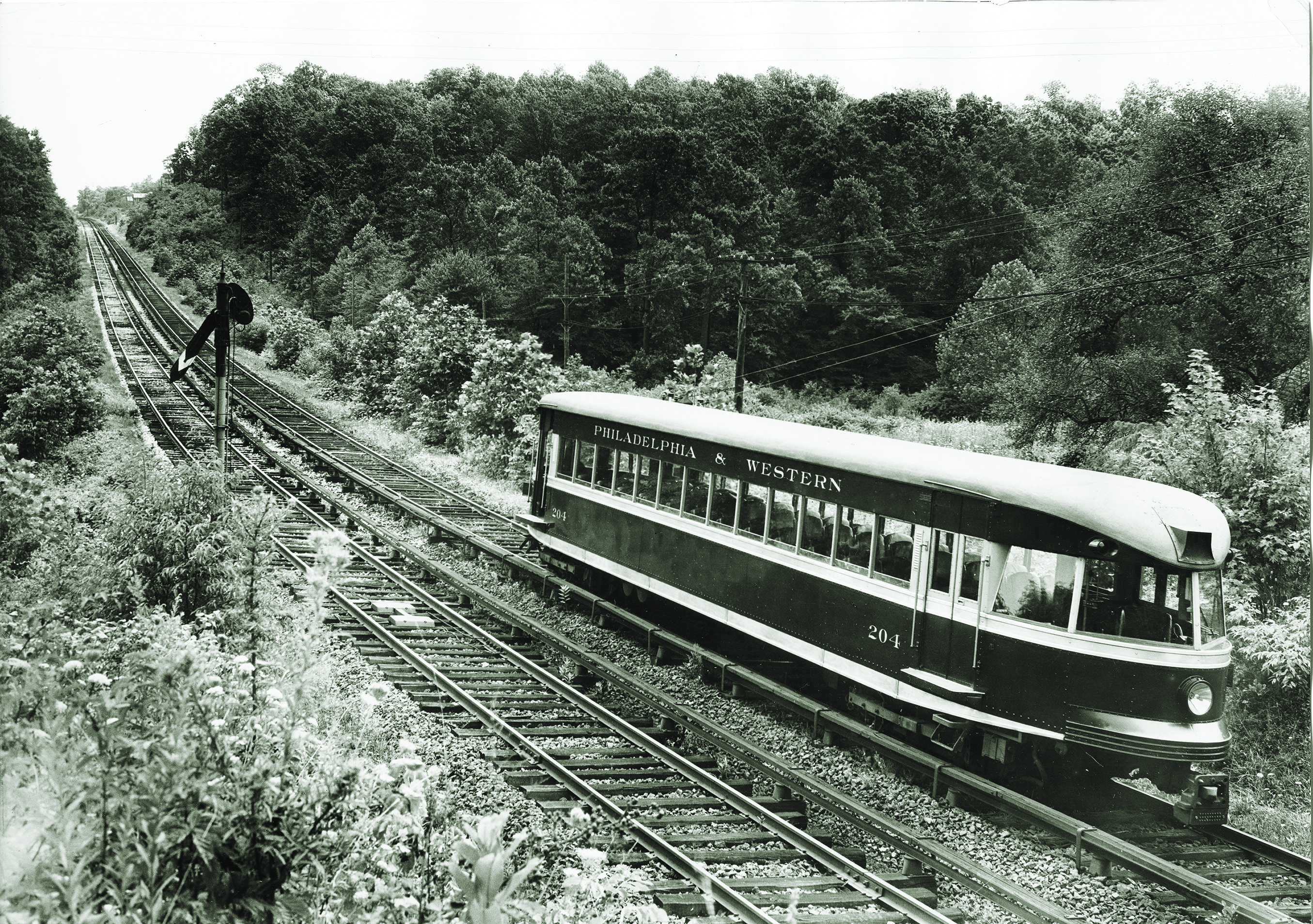
The Philadelphia and Western, which connected Philadelphia with its western suburbs, was one of the few interurbans powered not by overhead wires but a third, electrified rail. The P&W was always state-of-the-art, from its Bullet trains to former North Shore Electroliners renamed Liberty Liners. Since 1970, the surviving P&W line, renamed the Norristown High-Speed Line, has been part of Philadelphia’s SEPTA public transit system and, like Chicago’s South Shore, survives as a modern interurban. A second P&W line, abandoned, enjoys a new life as the Radnor hiking trail.
The Illinois Terminal—originally Illinois Traction—was started in the early 1900s by William B. McKinley—not the U.S. president, but an investment banker who later became a U.S. senator. The line ran from Peoria to St. Louis, Missouri. Starting in the 1930s management, while keeping passenger service, began to focus on doing more freight business and establishing interchanges with other freight lines. In 1948, Illinois Terminal bought new high-tech passenger cars called “Streamliners” that had trouble rounding curves in city streets. Interurban passenger service ended in 1956. The line continued as a freight railroad until the early 1980s, when it was absorbed by the Norfolk and Western.
_____
Everything old is new again
Classic interurban cars, usually restored by rail fans, are available for inspection and rides at railroad and trolley museums coast to coast. A fine example is Denver and Intermountain Railway Car No. 25, operated from 1911 until that line closed in 1950. In 1988, the Denver-based Rocky Mountain Railroad Club—rockymtnrrclub.org—embarked on a 20-year project aimed at restoring the vintage car. Volunteers spent more than 16,000 hours replacing wood components and window glass, installing new doors, and repainting in the original color scheme. Today, the group periodically takes the car out to offer free rides at the Denver Federal Center.
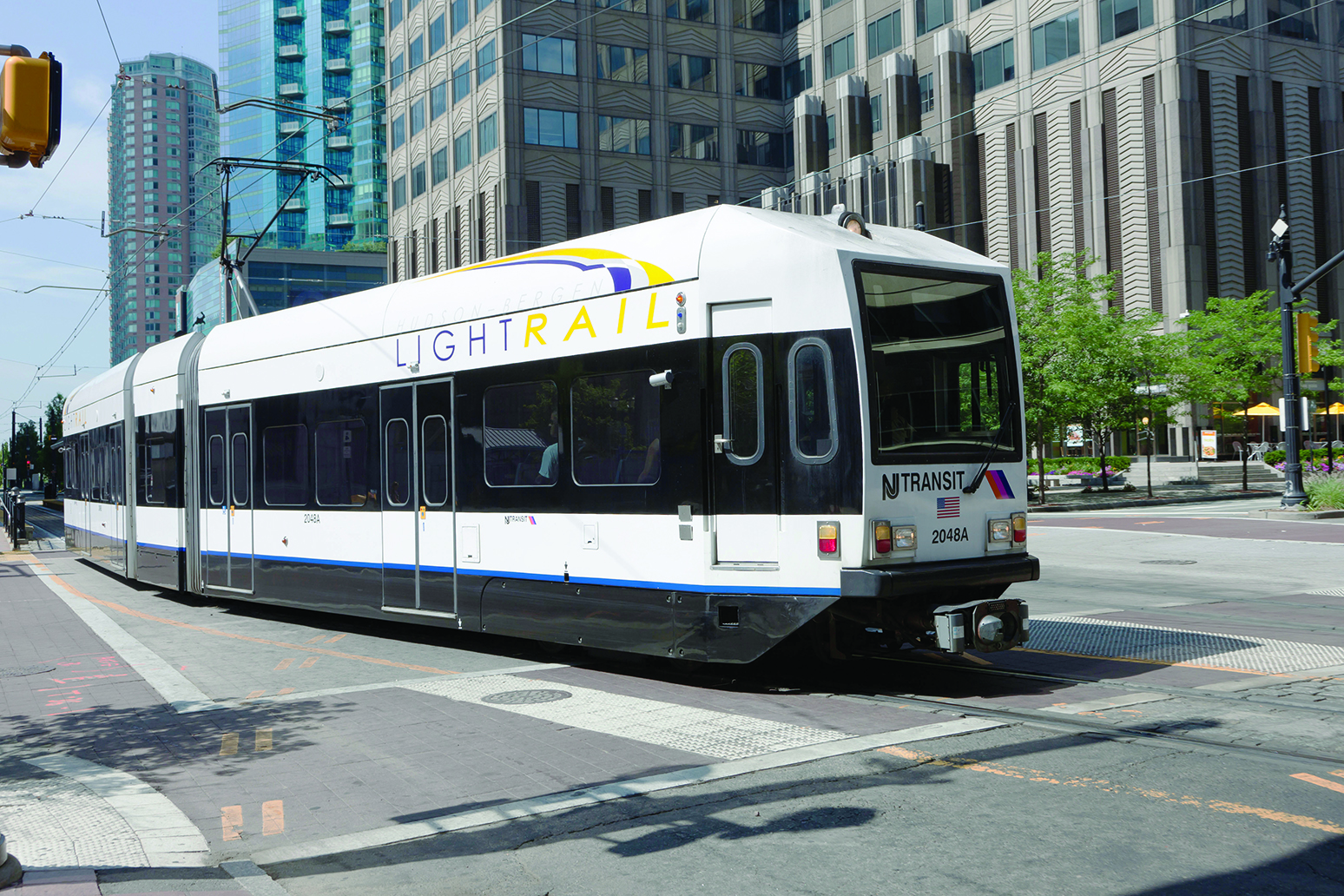
Since the 1970s, many cities, in response to congestion and smog, have built “light rail”—meaning vehicles like streetcars but with higher passenger capacity that, in some areas, use designated rights-of-way. Most light rail system systems operate within cities and their immediate suburbs, but a few might qualify as interurbans. For example, New Jersey Transit’s Hudson-Bergen Light Rail line connects Hoboken, Jersey City, Bayonne, and nearby towns. Such arrangements exemplify a significant difference between yesterday and today, says Orange Empire Museum curator Laner: “Light rail systems are operated by public entities that don’t have to show a profit the way the old interurbans did.” Many arriviste light rail systems follow the routes old interurban lines did. The first tracks Los Angeles laid for its new multi-line system, the Blue Line, follow the route of the Pacific Electric Long Beach line.
—Raanan Geberer

